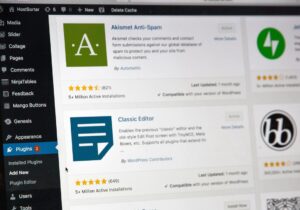Preparations and basics for the website
Just as rent is charged for a business, the same is true for storage space on a web server. That’s where the website finds its place, comparable to the plot of land for a house. Just as a house has an address, the website has a web address through which it can be reached.
You can get web space and a domain from a hoster for a monthly or annual fee. Depending on the size and requirements of the planned website, you can select a suitable package and specify your desired domain. Before registering, however, you should check whether the desired domain is also available.
When choosing the domain, the business name and, if possible, the industry should be accommodated. Let’s say it is a bakery called Leckerschmecker. Then a good option would be: “bäckerei-leckerschmecker.de”.
The basic structure of a website looks similar in most cases, but it clearly depends on what the web presence is intended to achieve. Here are the three most common pages and their functions:
- The home page
It can be compared to the store window of a store. Here you should catch the visitor’s eye and encourage him to look further. - About us / About me
This is a description of the company and the team behind it, perhaps with a compelling story about how it came to be and something about the individuals. Best embellished with suitable pictures. This way you build a good connection to the visitors. Because people prefer to do business with people. - Contact
Every contact possibility should be placed here. The address, phone number, opening hours, a contact form and preferably a map, so that you can get an idea of where the company is located.
In addition, there are company-specific pages (e.g.: services, work, portfolio, blog…) and the legal pages, such as imprint and data protection.
What should be achieved with the website?
The three most important questions to ask yourself:
For what reason do people go online, what are their online goals?
You have to be aware of your goals in order to know which way you want to take action.
For example, a hairdresser might have the following goals:
- Attract more customers
- Sell more products (e.g. sell hair care products online)
- Offer other services (e.g. hand care, make-up)
What do you expect from your visitors?
- Do you want to be called?
Then place your phone number clearly visible on every page. - Do you want customers to buy a certain product or take advantage of a certain offer?
Then let this stand out clearly. - Should customers be able to make appointments?
Then you clearly refer to the online appointment system.
What might website visitors be looking for?
To focus on exactly those elements that are actually relevant, it helps to put yourself in the customer’s shoes. It helps to ask friends and family or customers with whom you have already done business to find out what is important to them.
You should be able to answer these questions before you build your website.
Usability of the website
You should choose a simple and clear navigation. Here it is recommended not to stray too far from standard conventions. The main navigation should always be positioned clearly recognizable in the header or on the side of the website. In the mobile version, an easily recognizable icon should point to the navigation.
At least as important for the overview, is a uniform and clear layout. This way, the visitor always knows where he is and does not have the feeling that he has changed the page in the meantime.
If the page is more extensive, then a secondary navigation is advantageous, which shows where exactly you are (breadcrumbs).
Texts are best presented in dark font on a light background, as we are used to this and it makes the text more pleasant to read. On smaller devices, the most important content should remain in the foreground and not be obscured by an unnecessarily large graphic, for example.
The visitor should also become active on the website. You can ask your visitors to do this; for example, with a big “Call now!”, “Start with us!” or “Buy now” button.
Website contents
You should write with a confident attitude. It is advisable to leave out technical terms and self-praise as far as possible. The text should also not consist only of sales elements. Rather, the text should address the customer’s needs and show him how the product or service can help meet them. One should be recognizable as the problem solver. Honest reviews from already satisfied customers or a short story about how you solved customer XY’s problem, for example, help immensely. The best way to emphasize this is with a video in which the customer also says a few words about it. This increases credibility and creates trust.
The texts should be well structured and to the point. Too much text leads to it not being read at all.
Visitors who are lazy about reading are best reached via a short video. Here, the company and the services should be presented briefly and crisply. The key is to make it as clear as possible what the concept is and what problem it solves.
The texts should be embellished with authentic images. Stock photos are a very popular tool, but also very impersonal. The effort is a bit higher, but it is worthwhile to present the company with high-quality shots. This strengthens the personal level and creates more trust.
What other opportunities are there to promote the company online?
Entries in local online directories help to be found and at the same time they serve as a link to one’s own site, if one has provided the Internet address.
One should register the business with Google Places, this provides the opportunity to be displayed in the places in Google search.
Social media such as Facebook, Instagram, Google+ or Twitter are particularly suitable for establishing contact and relationships with customers. Here you can present photos of new products or creations and get in touch with customers directly.
It is important that contact data is formatted the same everywhere. (website, business directory listings, Google Places, social media).
If you follow all these points, the foundation of a successful Internet presence is set. After the website is online, the next step is to use analysis tools to plan further steps.




